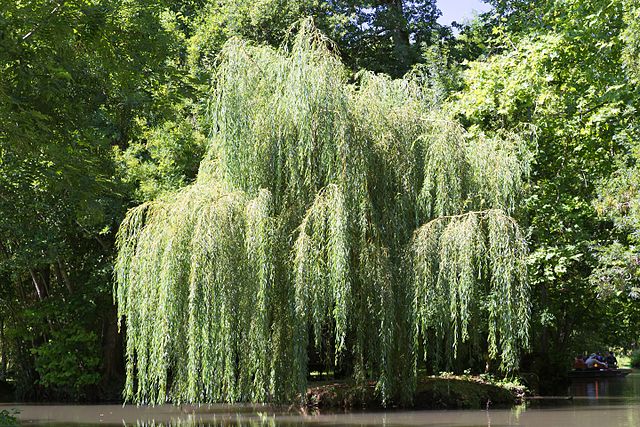This is the first part of a series on weeping willow cultivars.
Introduction
Weeping willow is a popular ornamental tree that is often selected for planting in landscape settings due to its elegant branching habit, and attractive, tan colored catkins. Throughout its range, numerous cultivars have been developed from weeping willow. Each cultivar exhibits its own unique traits. The following examines some of the most notable varieties, including ‘Babylon’, ‘Crispa’, ‘Elegantissima’, and ‘Pendula’.
‘Babylon’, also referred to as Babylonian weeping willow, is a medium to large sized tree that can reach heights of 30 to 50 feet, with a 20 to 40 foot spread. It has a fast growth rate, and a rounded, weeping habit. ‘Babylon’ has a graceful form. It is dense with festooning branches that trail down the length of the trunk. The shoots are a yellowish-brown color. The leaves are a light greyish-green on top, and dark green on the bottom. They turn golden yellow in fall. Each leaf is finely serrated, with toothed margins. The flowers are contained in tan colored catkins that appear in early spring. ‘Babylon’ is dioecious, meaning the male and female catkins grow on separate trees. ‘Babylon’ is resistant to hot conditions. This cultivar requires full sun. ‘Babylon’ weeping willow was traded along the Silk Road in Asia.
‘Crispa’, also referred to as ‘Annularis’ and Ram’s Horn Willow, is a medium sized tree that reaches heights of 30 to 40 feet, with a 20 to 30 foot spread. This cultivar has an upright, open habit, and develops at a slower rate than most other cultivars. The leaves are simple, narrow, and spirally-curled around the stems. The upper leaf surface is green, while the underside is an appealing silver tone. In fall, the leaves turn a vibrant golden-yellow. Small, yellow to tan catkins appear on the branches in spring. The male and female catkins typically form on separate trees. This cultivar is sterile. As such, it is considered non-invasive. ‘Crispa’ should be planted in sites exposed to full sun. Butterflies and hummingbirds can often be observed communing in the crown. ‘Crispa’ exhibits resistance to harsh climatic conditions, especially heat and heavy wind.
‘Elegantissima’ is a large ornamental tree, reaching heights of 50 to 60 feet, with an even spread. It has a distinctly pyrimidal growth habit, and long, pendulous branches that combine to form a narrow, conical crown. The leaves are long and narrow. They droop toward the ground, and appear to shimmer when blown about by heavy winds. The upper leaf surface is light green, while the lower surface is silver. By fall, the leaves turn a golden-yellow hue. ‘Elegantissima’ is hardier than many other weeping willow varieties. It tolerates a variety of soil types and climatic conditions. This cultivar requires full sun, and abundant moisture to flourish.
‘Pendula’ is a small multi-stemmed variety of weeping willow that is renown for its compact size. It grows at a fast rate, quickly reaching a height and spread of 5 to 8 feet. ‘Pendula’ has a rounded form, and strongly weeping branching habit. From late winter to early spring, large, silky catkins form on the pendulous branches. The pointed leaves are dark green through spring and summer, but brighten to a pale yellow in fall. ‘Pendula’ can be planted on sites ranging from full sun to partial shade. It is adaptable to a wide range of soil types.
If you have any questions about weeping willow, or you are interested in one of our tree services, contact us at 978-468-6688, or Sales@IronTreeService.com. We are available 24/7, and can accommodate any schedule. All estimates are free of charge. We look forward to hearing from you.
Photo courtesy of William Crochot CC-by-4.0


